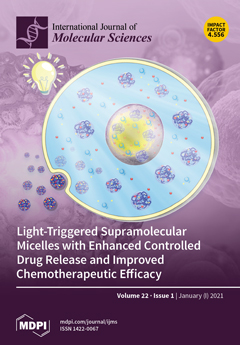The maternal-to-zygotic transition (MZT), which controls maternal signaling to synthesize zygotic gene products, promotes the preimplantation development of mouse zygotes to the two-cell stage. Our previous study reported that mouse granzyme g (Gzmg), a serine-type protease, is required for the MZT. In this
[...] Read more.
The maternal-to-zygotic transition (MZT), which controls maternal signaling to synthesize zygotic gene products, promotes the preimplantation development of mouse zygotes to the two-cell stage. Our previous study reported that mouse granzyme g (Gzmg), a serine-type protease, is required for the MZT. In this study, we further identified the maternal factors that regulate the
Gzmg promoter activity in the zygote to the two-cell stage of mouse embryos. A full-length
Gzmg promoter from mouse genomic DNA, FL-p
Gzmg (−1696~+28 nt), was cloned, and four deletion constructs of this
Gzmg promoter, Δ1-p
Gzmg (−1369~+28 nt), Δ2-p
Gzmg (−939~+28 nt), Δ3-p
Gzmg (−711~+28 nt) and Δ4-p
Gzmg (−417~+28 nt), were subsequently generated. Different-sized
Gzmg promoters were used to perform promoter assays of mouse zygotes and two-cell stage embryos. The results showed that Δ4-p
Gzmg promoted the highest expression level of the enhanced green fluorescent protein (EGFP) reporter in the zygotes and two-cell embryos. The data suggested that time-specific transcription factors upregulated
Gzmg by binding cis-elements in the −417~+28-nt
Gzmg promoter region. According to the results of the promoter assay, the transcription factor binding sites were predicted and analyzed with the JASPAR database, and two transcription factors, signal transducer and activator of transcription 3 (STAT3) and GA-binding protein alpha (GABPα), were identified. Furthermore, STAT3 and GABPα are expressed and located in zygote pronuclei and two-cell nuclei were confirmed by immunofluorescence staining; however, only STAT3 was recruited to the mouse zygote pronuclei and two-cell nuclei injected with the Δ4-p
Gzmg reporter construct. These data indicated that STAT3 is a maternal transcription factor and may upregulate
Gzmg to promote the MZT. Furthermore, treatment with a STAT3 inhibitor, S3I-201, caused mouse embryonic arrest at the zygote and two-cell stages. These results suggest that STAT3, a maternal protein, is a critical transcription factor and regulates
Gzmg transcription activity in preimplantation mouse embryos. It plays an important role in the maternal-to-zygotic transition during early embryonic development.
Full article






